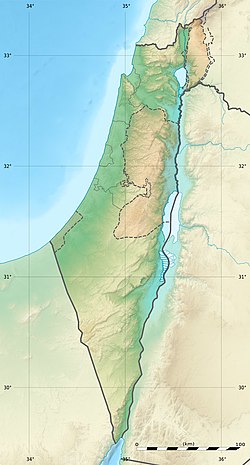
Back Ashkelon Afrikaans عسقلان Arabic ܐܫܩܠܘܢ ARC عسقلان ARZ Aşkelon Azerbaijani Ашкелон Byelorussian Askelan BEW Ашкелон Bulgarian আসকালান Bengali/Bangla Ascaló Catalan
Ashkelon
| |
|---|---|
| Hebrew transcription(s) | |
| • ISO 259 | ʔašqlon |
| • Translit. | Ashkelon |
| • Also spelled | Ashqelon, Ascalon (unofficial) |
Panorama of Ashkelon | |
| Coordinates: 31°40′N 34°34′E / 31.667°N 34.567°E | |
| Country | Israel |
| District | Southern |
| Founded |
|
| Government | |
| • Mayor | Tomer Glam |
| Area | |
• Total | 47,788 dunams (47.788 km2 or 18.451 sq mi) |
| Population (2022)[1] | |
• Total | 153,138 |
| • Density | 3,200/km2 (8,300/sq mi) |
| Website | www.ashkelon.muni.il |
Ashkelon or Ashqelon (/ˈæʃkəlɒn/ ASH-kə-lon; Hebrew: אַשְׁקְלוֹן, romanized: ʾAšqəlōn, IPA: [ʔaʃkeˈlon] ⓘ; Arabic: عَسْقَلَان, romanized: ʿAsqalān) is a coastal city in the Southern District of Israel on the Mediterranean coast, 50 kilometres (30 mi) south of Tel Aviv, and 13 kilometres (8 mi) north of the border with the Gaza Strip.
The modern city is named after the ancient seaport of Ascalon, which was destroyed in 1270 and whose remains are on the southwestern edge of the modern metropolis. The Israeli city, first known as Migdal, was founded in 1949 approximately 4 km inland from ancient Ascalon at the Palestinian town of al-Majdal (Arabic: الْمِجْدَل, romanized: al-Mijdal; Hebrew: אֵל־מִגְ׳דַּל, romanized: ʾĒl-Mīǧdal). Its inhabitants had been exclusively Muslims and Christians and the area had been allocated to the Arab state in the United Nations Partition Plan for Palestine; on the eve of the 1948 Arab–Israeli War the inhabitants numbered 10,000 and in October 1948, the city accommodated thousands more Palestinian refugees from nearby villages.[2][3] The town was conquered by Israeli forces on 5 November 1948, by which time much of the Arab population had fled,[4] leaving some 2,700 inhabitants, of whom 500 were deported by Israeli soldiers in December 1948[4] and most of the rest were deported by 1950.[5] Today, the city's population is almost entirely Jewish.
Migdal, as it was called in Hebrew, was initially repopulated by Jewish immigrants and demobilized soldiers. It was subsequently renamed multiple times, first as Migdal Gaza, Migdal Gad and Migdal Ashkelon, until in 1953 the coastal neighborhood of Afridar was incorporated and the name Ashkelon was adopted for the combined town. By 1961, Ashkelon was ranked 18th among Israeli urban centers with a population of 24,000.[6] In 2022 the population of Ashkelon was 153,138, making it the third-largest city in Israel's Southern District.[1]
- ^ a b "Regional Statistics". Israel Central Bureau of Statistics. Retrieved 21 March 2024.
- ^ Masalha, Nur (2012). The Palestine Nakba: Decolonising History, Narrating the Subaltern, Reclaiming Memory. London: Zed Books, Limited. pp. 115–116. ISBN 978-1-84813-970-1.
- ^ Morris, Benny (1 October 2008). 1948: A History of the First Arab-Israeli War. Yale University Press. p. 331. ISBN 978-0-300-14524-3 – via books.google.com.
- ^ a b B. Morris, The transfer of Al Majdal's remaining Palestinians to Gaza, 1950, in 1948 and After; Israel and the Palestinians.
- ^ Kimmerling, Baruch; S Migdal, Joel (2003). "Reconstituting Palestinian Nation". The Palestinian People: A History. Cambridge, Massachusetts: Harvard University Press. p. 172. ISBN 978-0-674-03959-9 – via books.google.com.
- ^ Cite error: The named reference
Golanwas invoked but never defined (see the help page).






